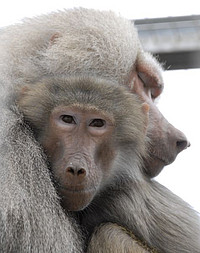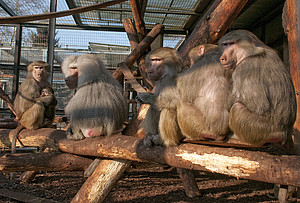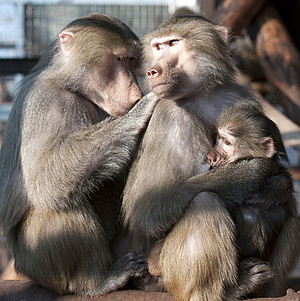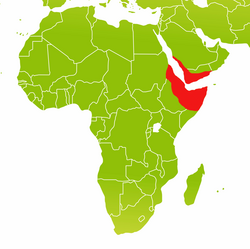Hamadryas baboon
Hamadryas baboons are common in Northeast Africa and in the Southwest of the Arabian Peninsula around the southern area of the Red Sea. How they ended up in the Arabian peninsula has not yet been clarified but it is likely that the baboons and humans crossed the Red Sea in the late Pleistocene, about 130,000 to 12,000 years ago. Due to the ice age-related decrease in sea levels, the possiblitity of a land bridge near the Straits of Bab-el-Mandeb, which links the Red Sea with the Gulf of Aden, exists.
Hamadryas baboons are the most northerly living baboon and the only ones that can be found outside of the African continent.
Special features
The animals show a distinctive sexual dimorphism. The males are up to 30 centimeters taller than the females and are often twice as heavy. In addition to the size and weight differences, the males are also distinguished by their striking, silver gray fur in the form of a mane that covered the head, shoulders and upper back. In contrast, the females have a shorter brownish fur. The canines of males are much longer than those of the females, this is however the case with almost all the primate species. For both sexes, the skin of the backside is red. The long tail is extended at the base in and curves upwards into the shape of an arch.
Diet
Since the hamadryas baboons are omnivorous, they eat both plants and animals. They are often found in savannahs and semideserts and feed mainly on grasses, tubers and other plant components such as fruits and flowers. As meat sources, they eat insects and scorpions as well as smaller lizards and mammals. In recent years, they have adapted their diet to the presence of humans in their habitat. They often use grain fields as food sources and search for food in landfills. A preferred food sorce of the baboons is the prickly pear that was introduced by humans. The cacti are available throughout the year and because of their high water content, it provides a valuable source of liquid for the baboons.
Habitat and lifestyle
The habitat of the baboons are savannahs, steppes, rocky deserts but also alpine grasslands up to 2600 m above sea level and wooded areas in the Horn of Africa and Arabia. They are dependent on water and are therefore never very far away from waterholes. Baboons are mostly on the ground and move around on all fours. During the night they move to rocky areas with cliffs, where they can find suitable places to sleep. In the daytime, they can cover up to 20 kilometers in search of food. Their home ranges comprise ten to 40 square kilometers and often overlap with those of other groups.
Social organization and reproduction
Hamadryas baboons organize themselves in a multi-level social system. The smallest social unit is the so-called one male unit (OMUs), which may include up to 15 animals. An alpha male lives with several females (usually two or three), their young and a few young males. The alpha male is the "leader" of the harem and is the only adult males that may mate with females of the group. The male watches over his females, keeps them together partly in an aggressive manner and prevents them from having contact with other males. The females are thus usually found near the alpha animal and pay special attention to him This is particularly reflected in the distinctive social grooming. Two to three OMUs form a clan. Within one of the clans the males are often related to one another. The members of a clan search for food together and exchange social interactions. Several clans eventually form a larger group, which can consist of up to 100 animals, and are know as “bands”. The members of a band share a grazing area and wander along together. At overnight spots, more than one band meet and spend the night in close proximity to each other. Such a sleeping place community is also known as a herd.
Hamadryan females reach sexual maturity at age four to five and the males later with six to nine years old. Mating and births occur throughout the year. During ovulation, the perineal region (region between the anus and genitals) of the female swells and turns red, which acts as an indication of the fertilization ability of the female to the male. Infants have black fur that changes color after three to six months. The older infants have the same color as the females. The mother carries the young on her belly and later on the back and nurses it eight to twelve months long. Although males also play with the infants and even allow them to go for short rides on their backs, the caring and rearing of infants is left to the females. Both male and female young baboons leave their birth groups before reaching sexual maturity. The females join other OMUs. In most cases, young females do not entirely leave their birth group voluntarily but are"kidnapped" by young adult males who form their own OMUs. The young males mostly remain in their clans, but are often not assigned a specific OMU. Since males cannot regularly mate with their own females, they try to establish their own OMU. They either join as a so-called "follower" of an OMU and try to replace the "old" leader of the OMU if it shows weakness, or they try to establish their own OMU with the kidnapped young females. This variation seems to be less risky for the males.
Source: Handbook of the Mammals of the World: Primates (edited by Mittermeier, R.A., Ryland, A.B., Wilson D.E., published by Lynx Edicions, Conservation International, IUCN, 2013)
Profile of the hamadryas baboon
| Scientific Name | Papio hamadryas |
|---|---|
| Taxonomie | Suborder: Family: Subfamily: Tribus: Gattung: Species: |
| Habitat | Southwest Saudi Arabia, West Yemen, Northeastern Sudan, East Eritrea, Djibouti, Northeastern Ethiopia, Northern Somalia |
| Head and body lenght | 70 - 95 cm 50 - 65 cm |
| Tail size | 42 - 60 cm 37 - 41 cm |
| Weight | 16,4 - 21,3 kg 10 - 15 kg |
| Diet | grass, grass seeds, roots, tubers, sprouts, fruits, young leaves, flowers of legumes, insects, scorpions, small lizards, small mammals |
| Lifestyle | diurnal, ground dwellers |
| Social Organization | multi-level system |
| Mating system | polygyn-monandrous (several females mate with one male) |
| Life expectancy (husbandry) | up to 30 years |
| Status (IUCN Red List) | least concern |




